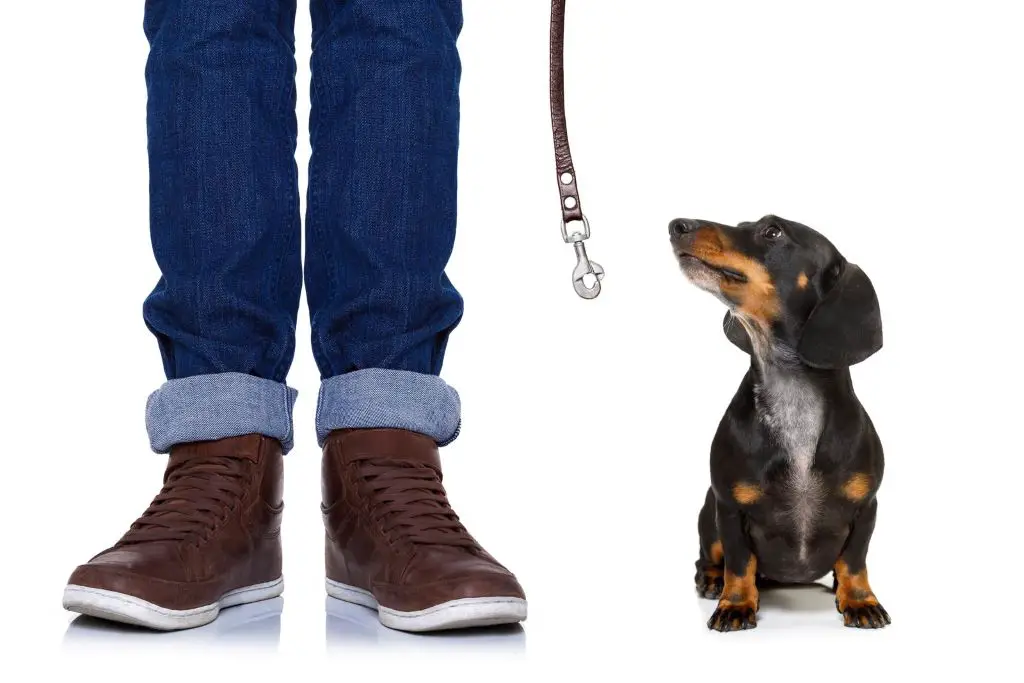Warning: Trying to access array offset on value of type bool in /home/u778996160/domains/dachshundtalk.com/public_html/wp-content/plugins/wp-word-count/public/class-wpwc-public.php on line 123
Warning: Trying to access array offset on value of type bool in /home/u778996160/domains/dachshundtalk.com/public_html/wp-content/plugins/wp-word-count/public/class-wpwc-public.php on line 123
So, you have a dachshund with back problems but are worried about being able to handle him due to his size and strength. Carrying a Dachshund with back problems can be challenging.
The good news is that there are ways to carry a dachshund with back problems that will make it easier on both of you. With some knowledge and diligence, you can be assured that your dog will be as happy and healthy as possible.
Today, I’m sharing five tips on how to carry your Dachshund with back problems.
How to Carry a Dachshund with Back Problems?
Dachshunds are known for their long backs, making carrying them challenging. Here are some tips on how to carry a dachshund with back problems.
1. Use a sling or wrap to support your Dachshund’s back and belly.
A sling or wrap can help to take some weight off your Dachshund’s back and spine. This can be especially helpful if your Dachshund has back problems or is recovering from surgery.
A sling or wrap will support your Dachshund’s back and belly while you carry them and can help to distribute their weight more evenly. This can help to prevent further injury and make carrying them more comfortable for both of you.
There are a variety of slings and wraps available, so be sure to choose one that is the right size and fit for your Dachshund.
- How to Choose the Size: Please consult our size chart to find the right fit for your pet. If your pet's weight falls on the borderline of sizes, please choose the larger size.
- Adjustable Shoulder Straps: The YUDODO dog carrier accommodates individuals of different heights with its anti-slip buckle design, ensuring stability.
- Comfortable and Breathable Material: Crafted from high-quality breathable materials, the YUDODO dog carrier keeps your pet cozy in all seasons, offering warmth in winter and coolness in summer. It's versatile for trips to the supermarket, park outings, gatherings, hiking, and keeping your furry companion by your side.
- Safety Comes First: 1. A safety buckle design secures your pet's collar to prevent escapes. 2. Anti-slip zipper design adds security. 3. Reflective stripes enhance visibility and safety during nighttime walks.
- Various Style Options: We offer a range of colors and sizes to suit your needs. With the YUDODO Dog Carrier, you'll stay fashionable while your pet stays close.
2. Place a pillow or soft support under your Dachshund’s chest and head.
Place a pillow or other soft support under their chest and head to keep them stabilized. This will help to keep your Dachshund’s spine in alignment and prevent further injury. You can carry them in your arms or in a pet carrier.
Always support your Dachshund’s head and neck when using a sling or wrap. You may also want to put a soft pillow or blanket in the bottom of the sling or wrap to provide additional support.
Never pick up a dachshund by their front legs, as this can put unnecessary strain on their back.
3. Make sure your Dachshund is comfortable and not in pain.
Carrying your Dachshund should not be painful for them. If they seem uncomfortable, stop and check to see if the sling or wrap is too tight or if the pillow needs to be adjusted.
If you have a dachshund with back problems, you’ll want to take extra care to ensure they’re comfortable and not in pain. Here are a few tips:
- Avoid carrying your Dachshund for long periods. If you must carry him or her, take breaks often to let your dachshund rest.
- Be careful when picking up your Dachshund. Avoid lifting him or her by the belly or legs. Instead, scoop your Dachshund up from under the chest, using your arms to support his or her back.
- Make sure your Dachshund has a comfortable place to rest. A soft bed or mat is ideal. Avoid hard surfaces that could put pressure on your Dachshund’s back.
By following these tips, you can help make sure your Dachshund is comfortable and not in pain.
4. Take your Dachshund to the vet for regular check-ups.
As a dachshund owner, it’s important to take your furry friend to the vet for regular check-ups. Dachshunds are prone to back problems, so it’s essential to keep an eye on their health and ensure they get the care they need.
This will help to catch any potential problems early and keep your Dachshund healthy. Here are some tips for taking your Dachshund to the vet:
- Make sure you have a good carrier for your Dachshund. A carrier that’s too small can put unnecessary pressure on your Dachshund’s back, so it’s important to find one that’s the right size. You can ask your vet for recommendations.
- When you put your Dachshund in the carrier, make sure they’re in a comfortable position. You don’t want them to be cramped up or have to put any strain on their back.
- When you get to the vet, tell them immediately that your Dachshund has back problems. This way, they can take extra care when examining your Dachshund.
- Be sure to ask the vet any questions about your Dachshund’s back problems. They can help you understand what’s going on and what you can do to help your Dachshund feel better.
Regular vet check-ups are an important part of keeping your Dachshund healthy, so make them a priority.
5. Be careful when carrying your Dachshund and watch for signs of discomfort.
As a Dachshund owner, it’s important to be aware of your dog’s back problems and take precautions when carrying them. Here are some tips on how to carry a Dachshund with back problems:
- When carrying your Dachshund, hold them close to your body and keep their back straight. Avoid letting them hang down or dangle, as this can pressure their spine.
- Put your Dachshund down carefully. When setting them down, always support their back end and let their hind legs touch the ground first. This will help prevent them from jarring their spine.
- Watch for signs of discomfort. If your Dachshund is whimpering, whining, or seems in pain, stop carrying them and consult your veterinarian.
How to Know If Your Dachshund Has Back Problems?
Well, you know what to do, but how do you know your Dachshund puppy has back problems in the first place?
Dachshunds are among the most popular dog breeds, and their long, low bodies make them unique and lovable. But this body type can also make them susceptible to back problems.
If your Dachshund is having trouble walking or seems to be in pain, it may have a back problem. There are a few things you can look for to see if your dog is having back problems:
- reluctance to move or exercise
- whimpering or crying when touched
- yelping when picked up or handled
- arched back
- hunched over appearance
- unwillingness to jump or climb stairs
- difficulty urinating or defecating
- tail tucking
Having these symptoms doesn’t necessarily indicate a back problem, but showing 3 or 4 of these symptoms means you’ve something to worry about.
In that case, the best thing to do is to take it to the vet. Back problems can be caused by several things, including injuries, degenerative diseases, and congenital abnormalities. Only a veterinarian can properly diagnose the cause of your Dachshund’s back problems and recommend the best course of treatment.
The vet will likely prescribe medication or recommend physical therapy. In some cases, surgery may be necessary to correct the problem.
Conclusion
If your Dachshund shows any signs of back pain, it’s essential to take them to the vet as soon as possible. Dachshunds are susceptible to back problems; if left untreated, they can become debilitating.
Early diagnosis and treatment are crucial to helping your Dachshund live a long and healthy life. Also, before getting the treatment, follow our tips on how to carry a Dachshund with back problems to keep them at ease. Don’t worry; everything will be fine!










